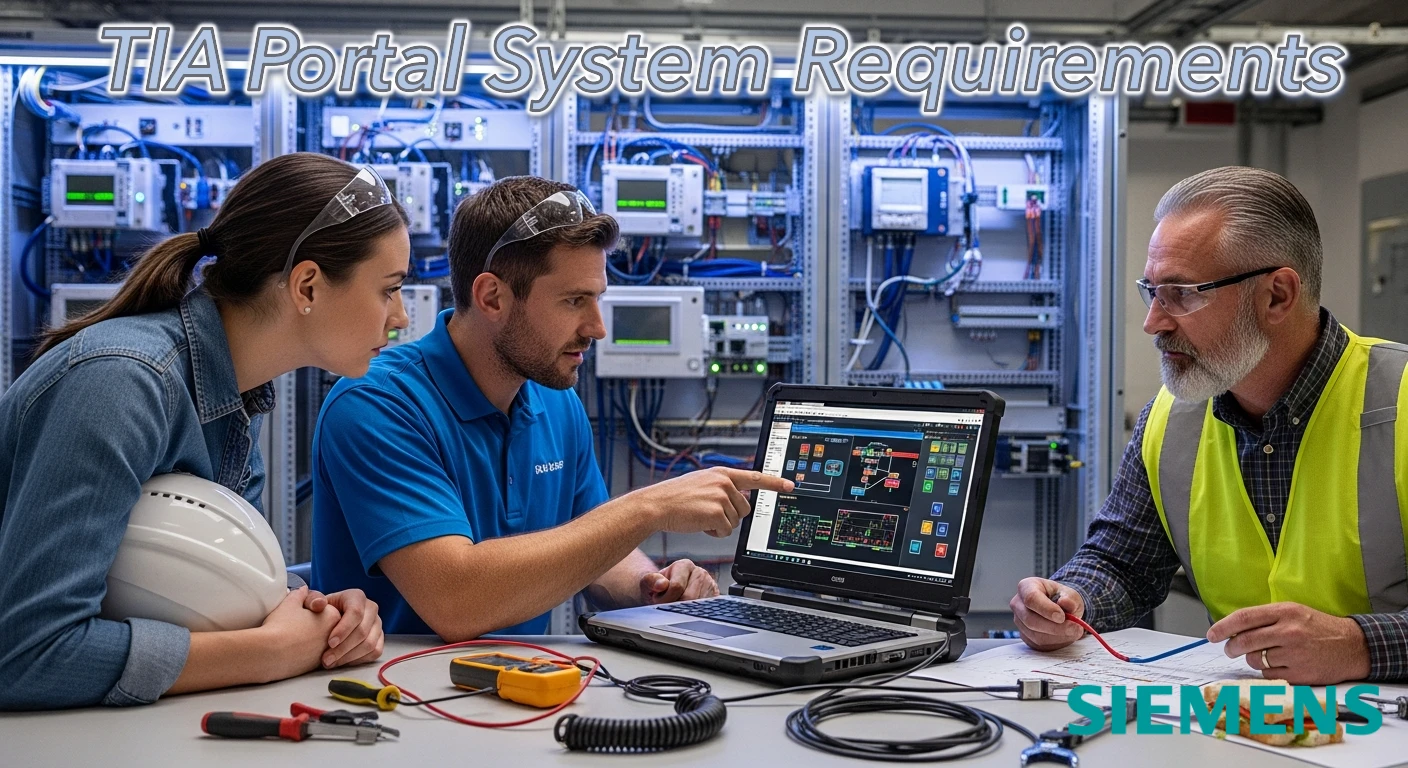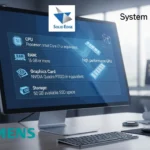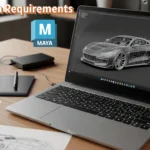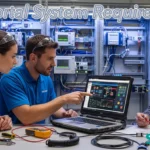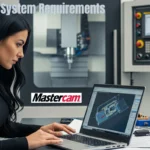Updated for the latest Siemens TIA Portal versions – V18, V19, and beyond.
If you’re about to install Siemens TIA Portal, there’s one thing you should double-check before hitting “Next”: your computer’s hardware.
TIA Portal is an incredible engineering suite — but it’s also a heavy one. The smoother your setup, the faster you can focus on programming PLCs, designing HMIs, or simulating real-world systems.
In this guide, we’ll break down everything you need to know about TIA Portal system requirements, from the bare minimum specs to the ideal setup for engineers who want speed, stability, and zero lag.
TL;DR — TIA Portal System Requirements
To run Siemens TIA Portal smoothly, aim for Windows 10/11 64-bit, a Core i5/i7 or Ryzen 5/7 CPU, 16–32 GB RAM, and an NVMe SSD. Integrated graphics are fine for basic PLC work, but a dedicated GPU helps with WinCC and large HMI projects. Always enable .NET Framework 3.5 SP1, keep drivers updated, and free up at least 50 GB of space. In short — a fast processor, plenty of RAM, and an SSD make all the difference.
Also Read: Best laptops for TIA Portal
🧠 What Is TIA Portal and Why Specs Matter
TIA Portal (Totally Integrated Automation Portal) is Siemens’ all-in-one software for PLC programming, HMI/SCADA design, and automation engineering.
It integrates tools like STEP 7, WinCC, and PLCSIM — which means it’s running multiple complex applications under one roof.
Because of that, hardware really matters.
If your PC doesn’t meet the requirements, you’ll feel it — slow project loading, lagging simulations, and endless compile times.
Let’s make sure that doesn’t happen.
⚙️ TIA Portal Minimum and Recommended Requirements (2025)
Here’s a quick breakdown of minimum vs recommended system requirements to keep things running smoothly. These specs apply broadly to TIA Portal V18, V19, and V20+.
| Category | Minimum Specs | Recommended Specs | For Large Projects / Simulation |
|---|---|---|---|
| CPU | Intel Core i3 / AMD Ryzen 3 | Intel Core i5 / Ryzen 5 (11th gen +) | Intel Core i7 / Ryzen 7 / Xeon |
| RAM | 8 GB | 16 GB | 32 GB – 64 GB |
| Storage | SSD (at least 50 GB free) | NVMe SSD (512 GB total) | NVMe SSD (1 TB +) |
| Graphics | Integrated GPU | Dedicated GPU for WinCC Unified or dual monitors | Dedicated GPU + multi-monitor setup |
| Display | Full HD (1920×1080) | Full HD or higher | Dual Full HD or 4K monitor |
| Operating System | Windows 10 64-bit | Windows 10 or 11 64-bit (supported builds only) | Same as recommended |
| Network | 100 Mbit Ethernet | 1 Gbit Ethernet (PLC communication) | 1 Gbit or faster, team projects |
💡 Pro tip: Always check the official Siemens compatibility list before upgrading Windows. Some TIA Portal versions don’t immediately support the latest Windows builds.
🛠️ Software Prerequisites
Before installation, make sure you have:
- .NET Framework 3.5 SP1 and 4.8+ enabled
- Admin rights on your PC
- Antivirus exclusions set for Siemens folders (to avoid installer issues)
- Latest graphics and chipset drivers installed
Optional but helpful:
- Microsoft Visual C++ redistributables
- Power plan set to High Performance in Windows
💻 Ideal PC or Laptop Setup for TIA Portal
If you’re buying a new laptop or PC for engineering work, here’s what I’d personally recommend (based on years of hands-on use):
✅ Processor: Intel Core i7 or Ryzen 7 (12th gen or newer)
✅ RAM: 32 GB DDR4/DDR5
✅ Storage: 1 TB NVMe SSD
✅ GPU: NVIDIA RTX A1000 / A2000 / or GTX series (for HMI/WinCC)
✅ Display: 15.6″ Full HD or dual monitor setup
✅ Network: Built-in Ethernet + stable Wi-Fi 6
These specs aren’t overkill — they’re perfect for future-proofing. If you plan to use WinCC Unified, PLCSIM Advanced, or multiple projects at once, the extra performance pays off.
🔍 Pro Tips for Faster Workflow
Even with strong hardware, performance depends on how you use it.
Here are some real-world engineering tips for better speed:
- Use SSDs only. HDDs will slow TIA Portal down drastically.
- Keep your drive at least 20% empty. The software caches data constantly.
- Use separate drives for VMs (if running simulations).
- Close other heavy apps like AutoCAD, Revit, or MATLAB while compiling.
- Backup projects regularly. Corrupted projects are rare, but they happen.
🧩 Common Bottlenecks (and Fixes)
| Problem | Likely Cause | Fix / Suggestion |
|---|---|---|
| Slow compile times | Low RAM / old HDD | Upgrade RAM + switch to SSD |
| Lagging WinCC screens | Weak GPU / low CPU threads | Use dedicated GPU + modern CPU |
| Freezing at startup | Antivirus blocking files | Add TIA Portal folders to exclusions |
| Slow PLCSIM performance | Insufficient RAM | Close VMs / add more memory |
| Install errors | Missing .NET or admin rights | Enable .NET + run as Administrator |
🧭 Final Thoughts
At the end of the day, TIA Portal isn’t just another app — it’s the heart of your automation workflow.
Give it a system that can breathe, and it’ll reward you with smoother builds, quicker simulations, and fewer crashes.
If you’re setting up your workstation soon, start by investing in:
- A fast SSD
- Plenty of RAM
- A reliable CPU
Your productivity (and patience) will thank you.
FAQs
Not necessarily. If you’re only working on small or medium projects, a mid-range laptop with a decent CPU and 16 GB of RAM will do fine. But if you’re running multiple simulations, WinCC Unified, or big projects, investing in better specs will save you a lot of time and frustration.
Yes, most recent versions — like V18, V19, and V20 — support Windows 11 64-bit. Just make sure you’re using a version that Siemens officially lists as compatible with your Windows build. It’s always worth checking their support page before installing.
The biggest culprits are usually limited RAM, a slow hard drive, or an outdated CPU. Switching to an SSD and upgrading to at least 16 GB (preferably 32 GB) of RAM usually makes a huge difference.
How to Check and Prepare Your PC for TIA Portal System Requirements
Time needed: 10 minutes
Follow these three simple steps to make sure your computer is ready for Siemens TIA Portal — from checking your specs to optimizing performance before installation.
- Check Your System Specs
Open your computer’s “System Information” or “About” section and note your CPU, RAM, and storage type.
Compare them to the official TIA Portal requirements:
*CPU: Intel Core i5 or higher
*RAM: 16 GB recommended
*Storage: SSD with 50 GB free space
If you’re below the minimum, consider upgrading before installing. - Prepare Windows and Software
Make sure your OS is compatible (Windows 10 or 11 64-bit) and fully updated.
Enable .NET Framework 3.5 SP1 and 4.8+, then add Siemens folders to your antivirus exclusions.
Run the TIA Portal installer as Administrator to avoid setup issues. - Optimize for Best Performance
After installation, switch your power plan to High Performance, keep at least 20% free disk space, and close background apps during programming.
If you’re using WinCC Unified or PLCSIM Advanced, allocate extra RAM (32 GB or more recommended) and consider a dedicated GPU.
